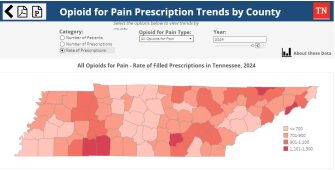The Ongoing Opioid Crisis in Tennessee and How Chiropractic Can Help
 The opioid epidemic is still on the news, in the papers, and all-over social media – the discussion continues as we learn more about its impact. While there have been efforts to increase awareness, enact legislation, and even legal implications since 2013, when the U.S. Department of Health and Human Services declared the misuse of prescription opioids an epidemic and since 2017, when the opioid epidemic was declared a national public health emergency, it remains a national crisis.
The opioid epidemic is still on the news, in the papers, and all-over social media – the discussion continues as we learn more about its impact. While there have been efforts to increase awareness, enact legislation, and even legal implications since 2013, when the U.S. Department of Health and Human Services declared the misuse of prescription opioids an epidemic and since 2017, when the opioid epidemic was declared a national public health emergency, it remains a national crisis.
According to the 2019 National Ambulatory Medical Care Survey, analgesics, (commonly known as pain relievers and including narcotic and nonnarcotic analgesics and nonsteroidal anti-inflammatory drugs) were the most frequently mentioned drugs during office visits (roughly 10% of visits).
In Tennessee, the publicity, preventative policies and regulations, and educational actions that have been taken by various groups across the state, including the TCA, and the nation have made a significant impact.
The TN Department of Health maintains the Tennessee Drug Overdose Dashboard to make available the most current “state, regional, and county level data on fatal overdoses, nonfatal overdoses and drug prescribing.” According to this tool, there were 4,418,587 opioid painkiller prescriptions written in 2024. While this is significantly down from over 5 million in 2020, it is still enough for over 60% of all Tennesseans (birth to the elderly) to have an opioid prescription. In fact, only 6 counties in Tennessee had rates at or below 50% (Davidson 41%, Knox 50%, Montgomery 43%, Rutherford 47%, Shelby 40%, Williamson 33%).

There are conditions for which the benefits of opioids are greater than the potential risk. In those cases, the medications can provide pain relief that other medications and treatment cannot. But for many types of musculoskeletal pain, there are a number of other treatments – including chiropractic care – that can provide safe, effective pain relief without the high risks associated with prescription opioids.
In fact, the American College of Physicians (ACP) published guidelines in April, 2017 regarding the treatment of acute, subacute, or chronic low back pain, recommending nonpharmacologic treatment first. When medications are needed, they recommend nonsteroidal anti-inflammatory drugs and suggest opioids only be considered when other treatments have failed. The ACP guidelines state that for patients with acute or subacute low back pain, “clinicians and patients should select nonpharmacologic treatment with superficial heat, massage, acupuncture, or spinal manipulation” and “for patients with chronic low back pain, clinicians and patients should initially select nonpharmacologic treatment with exercise, multidisciplinary rehabilitation, acupuncture, mindfulness-based stress reduction, tai chi, yoga, motor control exercise, progressive relaxation, electromyography biofeedback, low-level laser therapy, operant therapy, cognitive behavioral therapy, or spinal manipulation.”
Richard Shmerling, MD, a faculty editor for the Harvard Health Blog, states: “With the backdrop of the opioid crisis, we badly need an effective, safe, and non-opioid alternative to treat low back pain.” He goes on to reference and summarize one of the more recent research studies, published in the JAMA Network Open in May, 2018. This study reported:
After six weeks of treatment, those assigned to receive chiropractic care:
- reported less pain intensity
- experienced less disability and more improvement in function
- reported higher satisfaction with their treatment
- needed less pain medicine
Shmerling continues: This won’t be — and shouldn’t be — the last study of chiropractic care for low back pain. But until we know more, I’ll continue to offer it as one of many treatment options.”
With over 2,400 chiropractors currently licensed to practice in Tennessee, these doctors are ready and available to provide care for patients with neuromusculoskeletal conditions and help manage their pain. By using chiropractic as a first line treatment for conditions causing bone, muscle and joint pain, many patients may be able to avoid the need for prescription pain medications and thereby the risk of developing opioid addiction altogether. If medications are needed, your chiropractor can work with your other health care providers to provide treatments which may minimize the need for them, helping reduce the chances of side effects and addiction.
If you or a loved one is experiencing low back pain, or other musculoskeletal issues, talk to your doctor about which treatment options fit your health care needs. If you do not have a chiropractor, find a TCA member doctor near your home or work here.
REFERENCES:
National Center For Health Statistics National Ambulatory Medical Care Survey: 2019 National Summary Table
Tennessee Drug Overdose Dashboard https://www.tn.gov/health/health-program-areas/pdo/pdo/data-dashboard.html accessed 8/26/25
Goertz CM, Long CR, Vining RD, Pohlman KA, Walter J, Coulter I. Effect of Usual Medical Care Plus Chiropractic Care vs Usual Medical Care Alone on Pain and Disability Among US Service Members With Low Back Pain: A Comparative Effectiveness Clinical Trial. JAMA Netw Open. Published online May 18, 20181(1):e180105. doi:10.1001/jamanetworkopen.2018.0105
“Noninvasive Treatments for Acute, Subacute, and Chronic Low Back Pain” published at Annals.org on 14 February 2017. Accessed 8/26/25
TN Board of Chiropractic Examiners licensure 7/15/25 listing
Shmerling, Robert H. MD. “Should you see a chiropractor for low back pain?” Harvard Health Publishing. August 16, 2019. https://www.health.harvard.edu/blog/should-you-see-a-chiropractor-for-low-back-pain-2019073017412?fbclid=IwAR3YKYwiXe6o2xhOHY-cwAllIiWVI0XZmNp9sAkJtjq62UaxUo3ML5QSw8o accessed 8/28/25